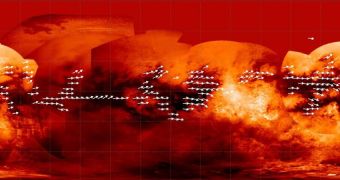Nearly four years of research data have been used by Cassini mission scientists to create one of the most complex and comprehensive maps of Saturn's largest moon, Titan, as far as winds go. The huge dunes on the surface of the planet have been believed for a long time to be the main factor responsible for the way wind blows on the surface of the natural satellite. Now, by combining numerous radar readings, astronomers have the first complete image of what can be thought of as an atmosphere on Titan.
“At Titan there are very few clouds, so determining which way the wind blows is not an easy thing, but by tracking the direction in which Titan's sand dunes form, we get some insight into the global wind pattern. Think of the dunes sort of like a weather vane, pointing us to the direction the winds are blowing,” Johns Hopkins University Applied Physics Laboratory Cassini radar scientist Ralph Lorenz, from Laurel, Maryland, explains. A scientific study details the finds in the February 11th issue of the journal Geophysical Research Letters.
“Titan's dunes are young, dynamic features that interact with topographic obstacles and give us clues about the wind regimes. Winds come at these dunes from at least a couple of different directions, but then combine to create the overall dune orientation,” Brigham Young University researcher Jani Radebaugh, from Provo, Utah, adds.
Earlier Cassini pictures have revealed that Titan's dunes are mostly oriented in an east-west direction, but, according to geologists, the winds that blow close to the surface may actually be moving towards the east. Simply put, if this turns out to be true, then it means that most of the previous models of Titan's winds are completely mistaken. Understanding exactly how winds blow on Saturn's moon is vitally important for a future mission, which NASA envisions to contain balloon-like observatories.
For the current research, some 16,000 dune segments have been extracted from 20 radar images, digitally enhanced, and combined to create the new digital picture. It's very difficult to map the entire surface of the satellite directly, because the Cassini space probe doesn't just orbit Titan, but all of Saturn's system. This year, for example, it will only make 17 flybys near the planet's moon.

 14 DAY TRIAL //
14 DAY TRIAL //